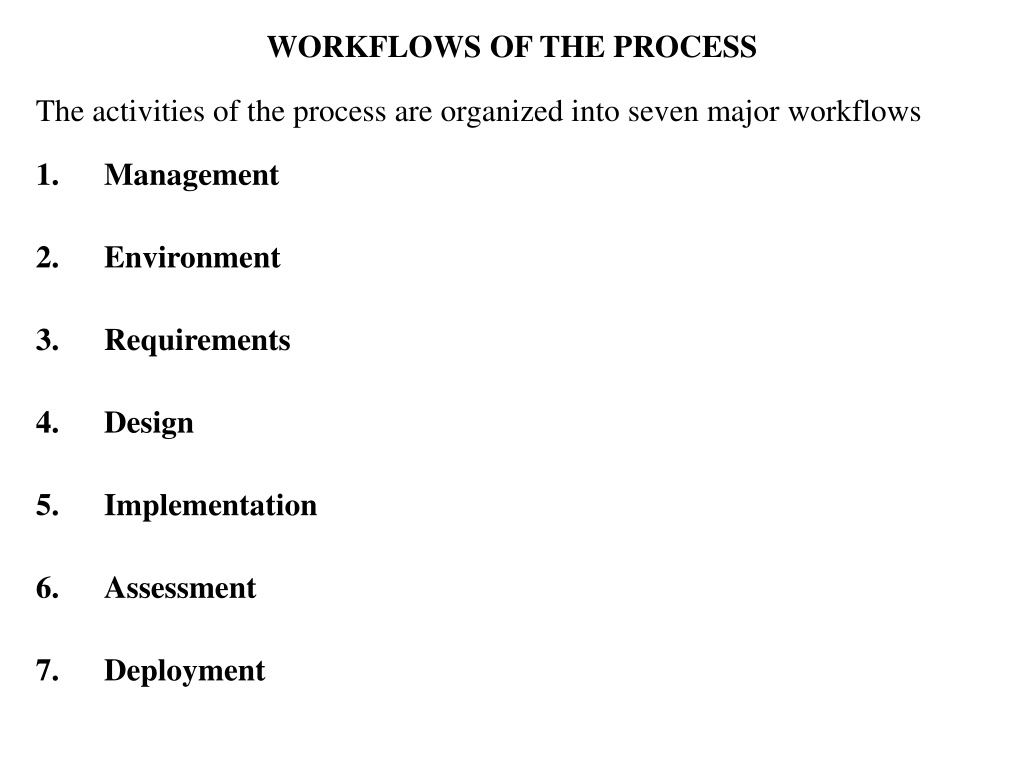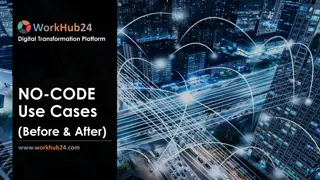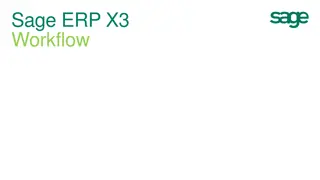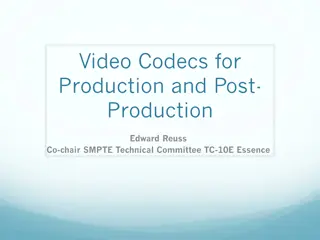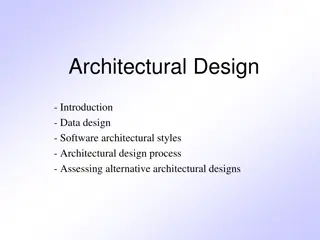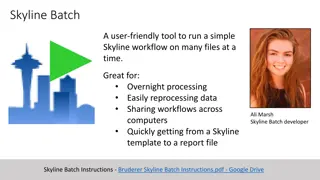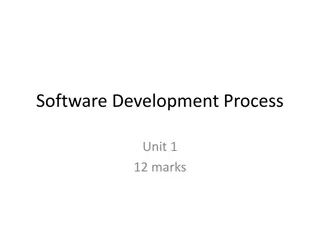Software Process Workflows and Management Overview
This content discusses the organization of activities into seven major workflows in the software development process, including Management, Environment, Requirements, Design, Implementation, Assessment, and Deployment. It highlights how these workflows are performed concurrently with varying effort levels and their significance in managing complexity in team-based software projects. The flaws in conventional software processes and the shift towards modern processes are also addressed. The content emphasizes the importance of understanding the phases and iterations in the software development life cycle to produce quality artifacts effectively.
Download Presentation

Please find below an Image/Link to download the presentation.
The content on the website is provided AS IS for your information and personal use only. It may not be sold, licensed, or shared on other websites without obtaining consent from the author. Download presentation by click this link. If you encounter any issues during the download, it is possible that the publisher has removed the file from their server.
E N D
Presentation Transcript
WORKFLOWS OF THE PROCESS The activities of the process are organized into seven major workflows 1. Management 2. Environment 3. Requirements 4. Design 5. Implementation 6. Assessment 7. Deployment
These activities are performed concurrently, with varying levels of effort and emphasis as a project progresses through the life cycle. The management workflow is concerned primarily with three disciplines. 1. Planning 2. Project Control 3. Organization
Most processes use sequences of activities as their primary representation format. Sequentially oriented process descriptions are simple to understand, represent, plan and conduct. From an individual s point of view, all activities are inherently sequential. Simplistic activity sequences are not realistic on software projects that are team efforts. Such efforts may include many teams, making progress on many artifacts that need to be synchronized, cross- checked, homogenized, merged and integrated. This distributed nature of the software process and its subordinate workflows is the primary source of management complexity.
One of the flaws in conventional software process was presenting the life cycle as a sequential thread of activities, from requirements to design to code to test to delivery. A modern process avoids the life cycle phases after the predominant activities. The phases inception, elaboration, construction and transition specify the state of the project rather than a sequence of activities. The intent is to recognize explicitly the amount of activities in all phases and avoid the interference that there is a sequential progression from requirements to design to code to test to delivery.
Software Process workflows The macroprocess comprises discrete phases and iterations, but not discrete activities. A range of activities occurs in each phase and iteration. The next-level process description is the microprocess or workflows, that produce the artifacts. The term workflow is used to mean a thread of cohesive and mostly sequential activities. Workflows are mapped to product artifacts and project teams. There are seven top-level workflows. 1. Management workflow : Controlling the process and ensuring win conditions for all stakeholders. 2. Environment workflow : Automating the process and evolving the maintenance environment.
3. Requirements workflow : Analyzing the problem space and evolving the requirements artifacts. 4. Design workflow : Modeling the solution and evolving the architecture and design artifacts. 5. Implementation workflow : Programming the components and evolving the implementation and deployment artifacts. 6. Assessment workflow : Assessing the trends in process and product quality. 7. Deployment workflow : Transitioning the end products to the user.
The principles of process framework are : 1. Architecture-first approach : Extensive assessment activities are performed before the construction phase, when full-scale implementation is the focus. b) This early life-cycle focus on implementing and testing the architecture must precede full-scale development and testing of all the components and must precede the downstream focus on completeness and quality of the entire breadth of the product features. a) requirements analysis, design implementation, and 2. Iterative life-cycle process : Each phase portrays at least two iterations of each workflow. b) Some projects may require only one iteration in a phase; others may require several iterations. c) The point is that the activities and artifacts of any given workflow may require more than one pass to achieve adequate results. a)
3. Round trip engineering a) Raising the environment activities to a first-class workflow is critical. b) The environment is the tangible embodiment of the project s process, methods, and notations for producing the artifacts. 4. Demonstration based approach a) Implementation and assessment activities are initiated early in the life cycle, reflecting the emphasis on constructing executable subsets of the evolving architecture. Some of the themes of the conventional process are not carried over in the workflows of the modern process. Their absence is equally important. Documentation is omitted because most documentation should be merely a secondary by-product of the other activities. Quality assurance is omitted because it is worked in all activities and not separated into a distinct workflow that operates independently from engineering or management,
Activity levels across the life cycle phases Inception Elaboration Construction Transition Management Environmen t Requireme nts Design Implementati on Assessmen t Deployment
The artifacts and life cycle emphases associated with each workflow WORKFLOW ARTIFACTS LIFE CYCLE PHASE EMPHASES Management Business case Inception : Prepare business case and vision Software development plan Elaboration : Plan development Status assessments Vision Work breakdown structure Construction : Monitor and control development Transition : Monitor and control deployment
WORKFLOW ARTIFACTS LIFE CYCLE PHASE EMPHASES Environment Environment Software change order database environment and software change order database Transition : Transition maintenance environment and software change order database Inception : Define development environment and change management infrastructure Elaboration : Install development environment and establish change management database Construction : Maintain development
WORKFLOW ARTIFACTS LIFE CYCLE PHASE EMPHASES Requirements Requirements set Inception : Define operational concept Release specifications Elaboration : Define architectural objectives Vision Construction : Define iteration objectives Transition : Refine release objectives
WORKFLOW ARTIFACTS LIFE CYCLE PHASE EMPHASES Design Design set Inception : Formulate architecture concept Architecture description Elaboration : Achieve architecture baseline Construction : Design components Transition : Refine architecture and components
WORKFLOW ARTIFACTS LIFE CYCLE PHASE EMPHASES Implementation Implementation set Deployment set Inception : Support architecture prototypes Elaboration : Produce architecture baseline Construction : Produce complete componentry Transition : Maintain components
WORKFLOW ARTIFACTS LIFE CYCLE PHASE EMPHASES Assessment Release specifications Inception : Assess plans, vision, prototypes Release descriptions Elaboration : Assess architecture User manual Construction : Assess interim releases Deployment set Transition : Assess product releases
WORKFLOW ARTIFACTS Deployment LIFE CYCLE PHASE EMPHASES Deployment set Inception : Analyze user community Elaboration : Define user manual Construction : Prepare transition materials Transition : Transition product to user
Iteration workflows An iteration consists of a loosely sequential set of activities in various proportions, depending on where the iteration is located in the development cycle. Each iteration is defined in terms of a set of allocated usage scenarios. The components needed to implement all selected scenarios are developed and integrated with the results of previous iterations. An individual iteration s workflow includes the following sequence : Management : Iteration planning to determine the content of the release and develop the detailed plan for the iteration Assignment of work packages or tasks to the development team. Environment : Evolving the software change order database to reflect all new baselines and changes to existing baselines for all product, test, and environment components.
Requirements : Analyzing the baseline plan, the baseline architecture, and the baseline requirements set artifacts to fully elaborate the use cases to be demonstrated at the end of this iteration and their evaluation criteria Updating any requirements set artifacts to reflect changes necessitated by results of this iteration s engineering activities. Design : Evolving the baseline architecture and the baseline design set artifacts to elaborate fully the design model and test model components necessary to demonstrate against the evaluation criteria allocated to this iteration Updating design set artifacts to reflect changes necessitated by the results of this iteration s engineering activities. Implementation : Developing or acquiring any new components, and enhancing or modifying any existing components To demonstrate the evaluation criteria allocated to this iteration, integrating and testing all new and modified components with existing baselines.
Assessment : Evaluating the results of the iteration, including compliance with the allocated evaluation criteria and the quality of the current baselines Identifying any rework required and determining whether it should be performed before deployment of this release or allocated to the next release Assessing results to improve the basis of the subsequent iteration s plan Deployment : Transitioning the release either to an external organization (such as user, independent verification and validation contractor, or regulatory agency) or To internal closure by conducting a post mortem so that lessons learned can be captured and reflected in the next iteration.
Iterations in the inception and elaboration phases focus on management, requirements, and design activities. Iterations in the construction phase focus on design, implementation, and assessment. Iterations in the transition phase focus on assessment and deployment. An iteration represents the state of the overall architecture and the complete deliverable system. An increment represents the current work in progress that will be combined with the preceding iteration to form the next iteration.
The workflow of an iteration Allocated usage scenarios Results from the previous iteration Management Requirements Design Implementation Assessment Deployment Up-to-date risk assessment Controlled baselines of artifacts Results for the next iteration Demonstrable results Requirements understanding Design features/performance Plan credibility
Iteration emphasis across the life-cycle Management Inception and Elaboration Phases Requirements Design Implementation Assessment Deployment Management Requirements Design Implementation Assessment Deployment Construction Phase
Management Requirements Design Implementation Assessment Deployment Transition Phase
CHECKPOINTS OF THE PROCESS It is always important to have visible milestones in the life cycle where various stakeholders meet, face to face, to discuss progress and plans. The purpose of these events is not only to demonstrate how well a project is performing but also to achieve - Synchronize stakeholder expectations and achieve concurrence on three evolving perspectives : the requirements, the design and the plan. Synchronize related artifacts into a consistent and balanced state. Identify the important risks, issues, and out-of-tolerance conditions. Perform a global assessment for the whole life cycle, not just the current situation of an individual perspective or intermediate project.
Milestones must have well-defined expectations and provide tangible results. This does not preclude the renegotiation of the mile stone s objectives once the project has gained further understanding of the requirements, design and plan.
KEY POINTS 1. Three sequences of the project checkpoints are used to synchronize stakeholder expectations throughout the life cycle : major milestones, minor milestones, and status assessments. 2. The most important major milestone is usually the event that transitions the project from the elaboration phase into the construction phase. 3. The format and content of minor milestones are highly dependent on the project and the organizational culture. 4. Periodic status assessments are crucial for focusing continuous attention on the evolving health of the project and its dynamic priorities.
Three types of joint management reviews are conducted throughout the process : 1. Major milestones : These system wide events are held at the end of each development phase. They provide visibility to system wide issues, synchronize the management and engineering perspectives, and verify that the aims of the phase have been achieved. Minor milestones : these iteration-focused events are conducted to review the content of an iteration in detail and to authorize continued work. Status assessments : These periodic events provide management with frequent and regular insight into the progress being made. 2. 3. Each of the four phases-inception, elaboration, construction, and transition-consists of one or more iterations and concludes with a major milestone when a planned technical capability is produced in demonstrable form.
An iteration represents a cycle of activities for which there is a well- defined intermediate result, a minor milestone, captured with two artifacts : 1. 2. A release specification ( the evaluation criteria and plan ) A release description ( the results ) Major milestones at the end of each phase use Formal Stakeholder-approved evaluation criteria and Release descriptions Minor milestones use Informal Development-team-controlled versions of these artifacts.
Major milestones The four major milestones occur at the transition points between life cycle phases. They can be used in many different process models, including the conventional waterfall model. In an iterative model, the major milestones are used to achieve concurrence among all stakeholders on the current state of the project. Different stakeholders have different concerns : Customers : Schedule and budget estimates, feasibility, risk assessment, requirements understanding, progress, product line compatibility. Users : Consistency with requirements and usage scenarios, potential for accommodating growth, quality attributes.
Architects and systems engineers : Product line compatibility, requirements changes, trade-off analysis, completeness and consistency, balance among risk, quality and usability. Developers : Sufficiency of requirements detail and usage scenario descriptions, frameworks for component selection or development, resolution of development risk, product line compatibility, sufficiency of the development environment. Maintainers : Sufficiency of product and documentation artifacts, understandability, interoperability with existing systems, sufficiency of maintenance environment. Others : Possibly many other perspectives by stakeholders such as regulatory agencies, independent verification and validation contractors, venture capital investors, subcontractors, associate contractors, and sales and marketing teams.
The milestones described may be conducted as one continuous meeting of all concerned parties or incrementally through mostly on-line review of the various artifacts. The essence of each major milestone is to ensure that the requirements understanding, the life-cycle plans, and the product s form, function and quality are evolving in balanced levels of detail and to ensure consistency among the various artifacts.
Status of plans, requirements and products across major milestones
LifeCycle Objectives Milestone It occurs at the end of the inception phase. Its goal is to present to all stakeholders a recommendation on how to proceed with development, including a plan, estimated cost and schedule, and expected benefits and cost savings. The vision statement and the critical issues relative to requirements and the operational concept are addressed. A draft architecture document and a prototype architecture demonstration provide evidence of the completeness of the vision and the software development plan. A successfully completed life-cycle objectives milestone will result in authorization from all stakeholders to proceed with the elaboration phase.
LifeCycle Architecture Milestone It occurs at the end of the elaboration phase. Its primary goal is to demonstrate an executable architecture to all stakeholders. A more detailed plan for the construction phase is presented for approval. Critical issues related to requirements and the operational concept are addressed. This review will also produce agreement on a baseline architecture, baseline vision, baseline software development plan, and evaluation criteria for the initial operational capability milestone.
The baseline architecture consists of both a human-readable representation and a configuration-controlled set of software components captured in the engineering artifacts. A successfully completed life-cycle architecture milestone will result in authorization from the stakeholders to proceed with the construction phase. The most important major milestone is the event that transitions the project from the elaboration phase into the construction phase, the content of the milestone is elaborated here in more detail. From management and contractual standpoint, this major milestone corresponds to achieving a software development state in which the research and development stage is concluding and the production stage is initiated.
A software development project ready for this transition exhibits the following characteristics : The critical use cases have been defined, agreed upon by stakeholders, and codified into a set of scenarios for evaluating the evolving architecture. 1. A stable architecture has been baselined in the source language format. Stability means that the important qualities of the architecture (performance, robustness, scalability, adaptability) have been demonstrated against the critical use cases to resolve all major requirements and design and planning risks. 2. The risk profile is well understood. 3. The development plan for the construction and transition phases is defined with enough fidelity that construction can proceed with predictable results. 4.
Engineering artifacts available at the life-cycle architecture milestone I II Requirements A. Use case model B. Vision document (text, use cases) C. Evaluation criteria for elaboration (text, scenarios) Architecture A. Design view (object models) B. Process view (if necessary, run-time layout, executable code structure) C. Component view (subsystem layout, make/buy/reuse component identification) D. Deployment view (target run-time layout, target executable code structure) E. Use case view (test case structure, test result expectation) 1. Draft user manual III Source and executable libraries A. Product components B. Test components C. Environment and tool components
Default agendas for the life-cycle architecture milestone Presentation Agenda I. Scope and objectives (Demonstration overview) II. Requirements assessment (Project vision and use cases, Primary scenarios and evaluation criteria) III. Architecture assessment (Progress, Quality) IV. Construction phase plan assessment (Iteration content and use case allocation, next iterations detailed plan and evaluation criteria, elaboration phase cost/schedule performance, construction phase resource plan and basis of estimate, risk assessment) Demonstration Agenda I. Evaluation criteria II. Architecture subset summary III. Demonstration environment summary IV. Scripted demonstration scenarios V. Evaluation criteria results and follow-up items
Initial Operational Capability Milestone It occurs late in the construction phase. The goals are to assess the readiness of the software to begin the transition into customer/user sites and to authorize the start of accepting testing,. Issues are addressed concerning installation instructions, software version descriptions, user and operator manuals, and the ability of the development organization to support user sites. Software metrics quality are reviewed to determine whether quality is sufficient for transition. The readiness of the test environment and the test software for acceptance testing is assessed. Acceptance testing can be done incrementally across multiple iterations or can be completed entirely during the transition phase.
The initiation of the transition phase is not necessarily the completion of the construction phase. These phases typically overlap until an initial product is delivered to the user for self-sufficient operation.
Product Release Milestone It occurs at the end of transition phase. Its goal is to assess the completion of the software and its transition to the support organization. The results of acceptance testing are reviewed, and all open issues are addressed. These issues could include installation instructions, software version descriptions, user and operator manuals, software support manuals, and the installation of the development environment at the support sites. Software quality metrics are reviewed to determine whether quality is sufficient for transition to the support organization.
Minor milestones The number of iteration-specific, informal milestones depends on the content and length of the iteration. Only two minor milestones are needed : 1. The iteration readiness review : This informal milestone is conducted at the start of each iteration to review the detailed iteration plan and the evaluation criteria that have been allocated to this iteration. 2. The iteration assessment review : This informal milestone is conducted at the end of each iteration to assess the degree to which the iteration achieved its objectives and satisfied its evaluation criteria, to review iteration results, to review qualification results, to determine the amount of rework to be done, and to review the impact of the iteration results on the plan for subsequent iterations.
For longer iterations, more intermediate review points may be necessary. All iterations are not created equal. An iteration can take on very different forms and priorities, depending on where the project is in the life cycle. Early iterations focus on analysis and design, with substantial elements of discovery, experimentation, and risk assessment. Later iterations focus much more on completeness, consistency, usability, and change management.
The milestones of an iteration and its associated evaluation criteria need to focus the engineering activities on the project priorities as defined in the overall software development plan, business case, and vision. The format and content of these minor milestones tend to be highly dependent on the project and organizational culture.
Typical minor milestones in the life cycle of an iteration Management Requirements Design Implementation Assessment Deployment Iteration N - 1 Iteration N Iteration N + 1 Iteration Readiness Review Iteration Assessment Review Iteration Design Walkthrough Iteration N Initiation Iteration N Closeout
Periodic Status Assessments Managing risks require continuous attention to all the interacting activities of a software development effort. Periodic status assessments are management reviews conducted at regular intervals to address progress and quality indicators, ensure continuous attention to project dynamics, and maintain open communications among all stakeholders. The principal objective of these assessments is to ensure that the expectations of all stakeholders are synchronized and consistent. Stakeholders can be contractor, customer, user, subcontractor. They serve as project snapshots.
Status assessments provide the following : 1. A mechanism for openly addressing, communicating, and resolving management issues, technical issues, and project risks. Objective data derived directly from on-going activities and evolving product configurations. A mechanism for disseminating process, progress, quality trends, practices, and experience information to and from all stakeholders in an open forum. 2. 3. Recurring themes from unsuccessful projects include status assessments that are 1. High-overhead activities, because the work associated with generating the status is separate from the everyday work. Frequently cancelled, because of higher priority issues that require resolution. 2.
Recurring themes from successful projects include status assessments that are 1. Low-overhead activities, because the material already exists as everyday management data 2. Rarely cancelled, because they are considered too important. They are crucial for focusing continuous attention on the evolving health of the project and its dynamic priorities. They force the software project manager to collect and review the data periodically, force outside peer review, and encourage dissemination of best practices to and from other stakeholders.
Default content of status assessment reviews Personnel : a) Staffing plan Vs. Actual s b) Attritions, Additions Financial Trends : a) Expenditure plan Vs. Actual for the previous, current, and next major milestones b) Revenue forecasts Top 10 risks : a) Issues and criticality resolution plans b) Quantification ( cost, time, quality ) of exposure Technical progress : a) Configuration baseline schedules for major milestones b) software management metrics and indicators c) Current change trends d) Test and quality assessments Major milestone a) Plan, schedule, and risks for the next major plans and results milestone b) Pass/fail results for all acceptance criteria Total product scope : a) Total size, growth, and acceptance criteria perturbations
